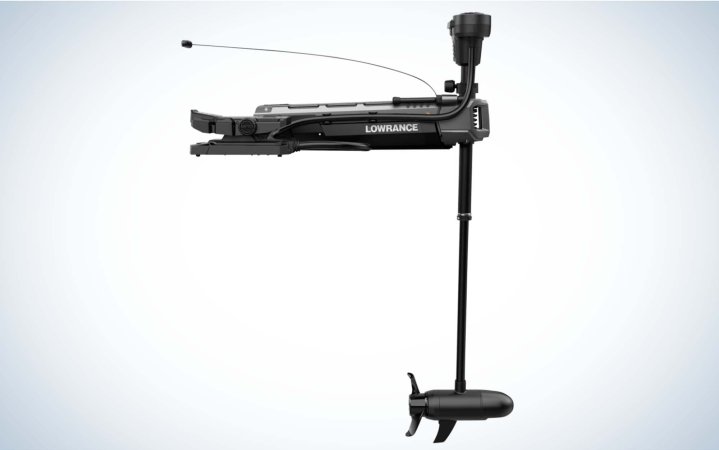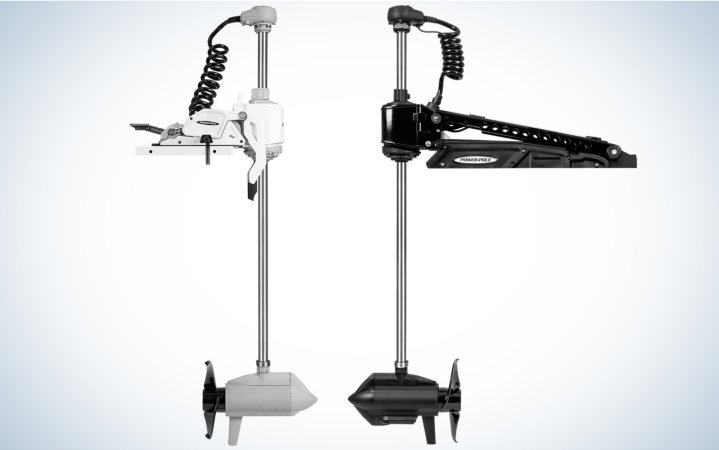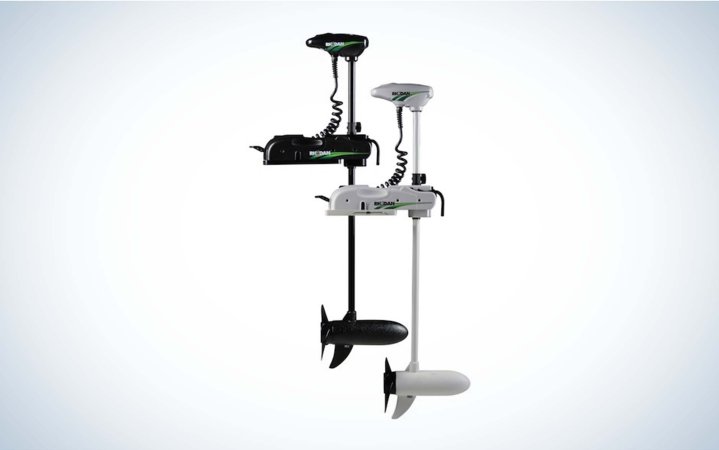Best Trolling Motors of 2024

We may earn revenue from the products available on this page and participate in affiliate programs. Learn More ›
When I bought my first used bass boat in the fall of 1996, it came with a bow-mounted, foot-controlled trolling motor with a whopping 43 pounds of thrust. It was a “12/24” model, able to switch from running on one deep cycle battery to going into a supercharged mode that drew upon two batteries equally. That marvel of engineering got bogged down in even modest grass beds, and I learned to carry and replace the steering cable, which had the habit of binding up and breaking when it hit cover, and once just from flopping while driving down the road.
Little did I know that 25 years later my new trolling motor would have more than 100 pounds of thrust at my disposal, drawing from three marine batteries. I’d link it to my electronics, including GPS, and it could autopilot me from one spot to another, or hold me steady on a predetermined waypoint. Furthermore, I’d be able to outfit it with various accessories—including levers, cable jackets, specialized prop nuts and aftermarket props—to enhance its performance. Finally, and perhaps most importantly, today’s trolling motors are more durable that those of a generation ago. It used to be that if you hit a stump, or even just got bogged down in grass, steering cables and shafts and other internal parts would break. With today’s beefed-up build quality and breakaway mounts, you can just keep on trucking.
We’re living in a golden age of electric trolling motor efficiency, and that’s bolstered by the fact that we have four main players in the field. By the late 1990s, we were effectively down to two, MotorGuide and Minn Kota, but with the addition of Lowrance’s proprietary products as well as those of mainstream electronics manufacturer Garmin, we now have an arms race of epic proportions to keep your boat under silent trolling motor power. There are rumors of a fifth competitor entering the fray either this year or next. For now, here’s the best trolling motors for fresh or saltwater.
Best Trolling Motors for Freshwater
Best Trolling Motors for Saltwater
Best Trolling Motors for Freshwater: Reviews & Recommendations
Check Latest Price
Minn Kota’s Ultrex completely raised the bar in what was then a two-horse race when the company introduced the Ultrex in 2017. Anglers had utilized GPS functionality extensively for well over a decade before, but never before in seamless concert with their electric trolling motor. While the motor was made to “go,” perhaps the greatest innovation was the ability to stop and stay – with Spot-Lock, the motor could keep a boat fixed on a GPS coordinate, even in the teeth of strong winds or heavy currents. Today’s Ultrex models build upon that strong start, and come in multiple models—both 24 and 36-volt versions, requiring two and three batteries, respectively, and 45 and 52-inch shafts to account for different boats and fishing styles.
The I-Pilot feature, which can be controlled from a remote control or a telephone app, is a huge part of pro angler Keith Combs’ success. He prefers to fish offshore, and noted that he can retie or take care of other business and let the motor pull him to a preset waypoint unattended. When operated manually, the steering is remarkably smooth and can be locked so it stays in the predetermined position if you take your foot off of it. Combs said that when fishing a grass line, he’ll often use the “jog” feature, which moves him in 5-foot increments, allowing him to cover an area precisely and thoroughly.
In the past, interference from jostled or improperly mounted transducers sometimes led to imperfect or malfunctioning electronics, essentially making them heavy paperweights, but with integrated transducers with down-imaging and/or side-imaging technology the Ultrex provides maximum clarity. Humminbird is the only brand that offers 360-degree sonar technology as well as Mega Live forward-facing sonar, and Combs said he uses them in tandem, with the Ultrex as his base of operations. Select models have built-in Mega Down Imaging.
This remote control trolling motor comes in 45-, 52- and 60-inch lengths, and both 24- and 32-volt systems which provide a maximum of 80 and 112 pounds of thrust, respectively. They come with a limited lifetime warranty on the shaft and a limited 3-year warranty on everything else. Minn Kota also makes a great trolling motor for kayaks.

Check Latest Price
Lowrance, a longtime leader in marine electronics, ever since founder Darrell Lowrance introduced the “Fish-Lo-K-Tor” commonly referred to as the “little green box,” jumped into the trolling motor game with the Ghost freshwater trolling motor. Since it was their first trolling motor, they claimed that it allowed them to build it from the ground up, learning from the mistakes or omissions their predecessors.
Clark Reehm, who fishes the Tackle Warehouse Pro Circuit and guides on Lake Sam Rayburn in Texas, said that the most important thing about his Ghost is the brushless motor, which allows it to be more energy-efficient. “I can make my batteries last much longer in the day,” he said. “That enables me to look for bedding fish for several more hours or to fight current and big waves without worrying that I’ll run out of power.”
He also likes the fact that the motor does not interfere with his four Lowrance HDS12 sonar units, and moreover pairs easily with them to maximize the use of his DownScan Imaging and Active Imaging technologies, with a minimal learning curve. It’s how he makes his living, but he said that’s critical for the weekend warrior who wants to get out on the water and start finding and catching fish immediately. Finally, he said it’s durable, and the composite shaft has a lifetime warranty if for some reason the 360-degree breakaway mount doesn’t protect it.
Whether you’re left-footed or right-footed, the pedal can be configured so that you’re most comfortable, and the motor’s functions can be set up in various permutations, to put the ones you like and use most where they’re most accessible.
The Ghost comes in 47-, 52-, and 60-inch shaft lengths and both 24- and 36-volt systems that provide up to 97- and 120-pounds of thrust. Lowrance offers a limited lifetime warranty on the composite shaft and a limited three year warranty on the rest of the motor.

Check Latest Price
Just as Minn Kota/Humminbird were the first to bring the spot lock trolling motor feature to wide use, Garmin was the first brand to popularize forward-facing sonar, in the form of their Garmin Panoptix LiveScope system, and they paired it their proprietary Force trolling motor to get the most out of the technology.
Missouri bass pro Chad Morgenthaler said that “because of the brushless trolling motor, I get zero interference whether I’m looking forward or down.”
He also believes that the supposed 100 pounds of thrust is a vast underrating. “I can’t prove it, but it’s way more powerful than anything else I’ve ever used. Even with my 21 foot Phoenix boat loaded heavy, with the trolling motor wide open I’ve run it as fast as 4.1 miles per hour.”
Garmin has distinguished themselves with wireless technology. Not only does the trolling motor connect wirelessly to your chart plotter and offer built-in sonar capabilities, but the foot pedal can be operated wirelessly (using AA batteries). It can also be hard wired if an angler does not trust that set-up. The Force comes with a floating, water-resistant remote control that can be customized to offer a wide variety of features.
The Force combines excellent power with world class electronics to give anglers one of the best trolling motors. It’s available in both 50- and 57-inch shaft lengths. It comes with a 3-year warranty and a limited lifetime warranty on the shaft.
Best Trolling Motors for Saltwater: Reviews & Recommendations
Most Indestructible: Power Pole Move

See It
Rumors of an imminent Power Pole trolling motor started circulating several years ago. Still, the company delayed the public release until early 2023 because they wanted to stress test the heck out of it. They put it through every possible rigor and obstacle before releasing it to the public. That’s typical of the company, which built its name through innovative shallow water anchoring systems, but cemented its legacy through customer service and by overengineering its products. This new trolling motor lives up to that latter legacy insofar as you can crash through waves, bang into stumps, run it all day at high speed, and still keep ticking.

There are two different models, the ZR and the PV, with a scissor lift and pivot mount, respectively, but that’s a major difference. They’re both made to be corrosion-resistant in fresh and saltwater and with various backup systems to guard against losing your ability to use the motor when you need it most. That starts with a titanium shaft (45, 52, or 60 inches) with an unconditional lifetime warranty and extends to the ultra-quiet brushless motor. Even the propeller is custom-made to be more efficient and weedless, and you can run the motor on 24 or 36 volts of battery power.
The Move has new tech like a wireless pedal, wireless remote control, and wireless foot switches. Still, the real advantage is the ability to pair them with the best fish finders, particularly with Lowrance and Simrad units. The ZR even has an optional built-in transducer for Lowrance units. The motor has anchor mode, a vector mode, and a compass heading, but the most impressive is the “Follow a Route,” which allows anglers to set a complex and winding route ahead of time, and the motor will trace it flawlessly.

See It
The Motorguide Xi3 is a great choice for kayak anglers looking to motorize their fishing kayak. The 36-inch shaft is the perfect size for a small boat, and 55 pounds of thrust moves the kayak faster than you can pedal or paddle. The big draw for the Xi3 is the remote control. Mount the motor on the bow and wirelessly control direction and speed. The Xi3 has many of the premium features of larger trolling motors, such as GPS control, virtual anchor, programmable routes, and autopilot.
Installation is easy, many kayaks are pre-rigged with threaded inserts in the bow and stern to install a standard trolling motor base. Simply bolt on the Xi3 base, plug into a 12-volt, deep-cycle marine battery, and you’re ready to go. The Xi3 has a large lever to make it easy to stow and deploy, even from the kayak seat. I can use the Xi3 with any of the best kayak fish finders to combine my transducer and trolling motor. To monitor motor functions and battery power, the Xi3 has an LED display, so I never run out of juice. Not only is the Xi3 perfect for maneuvering the kayak while I’m fishing, I use the motor to power to and from the fishing grounds. Having the power of an electric trolling motor makes me more confident and expands the horizons for my fishing kayak.

See It
Everyone wants the convenience and control of the best trolling motors, even anglers in large sportfishing boats. To meet the need, Minn Kota’s Riptide Terrova is available with an 87-inch shaft and 112 pounds of thrust. That’s sufficient size and power for a boat over 25-feet long. Using a trolling motor on an offshore boat, I can hold the boat on structure, slow troll down a weedline, or repeat a programmed drift.
The Terrova even serves as autopilot to take me back to a saved position. I gain further control of the motor’s features and functions from the fish finder screen, my smartphone, or with the handheld remote with a color touchscreen. On a big boat, I need to control the trolling motor from the helm and the cockpit. Using the Terrova’s integrated control, I can use the remote or my fish finder to run the motor. For offshore and inshore anglers looking for ultimate boat control, the Riptide Terrova offers the most advanced trolling motor features with a long shaft and high-power propulsion system.

See It
Anglers powering a small skiff, jon boat, flat transom canoe or kayak need a transom mount trolling motor with a tiller drive. Newport Vessels NV trolling motor provides reliable power at a great price. Available with a 30 or 36-inch shaft and power from 33 to 86 pounds, there is an NV model to fit any small watercraft. The NV has five forward speeds and three reverse speeds with smooth transitions between settings. To monitor battery life, an LED display keeps track of the remaining power. The Newport Vessels NV is simple and inexpensive, but it is also durable with corrosion-resistant components and sturdy construction. Electric motors are lighter and safer than a small gas outboard, and the Newport Vessels NV is also less expensive and easier to operate.

See It
The most accurate GPS available puts the Rhodan HD GPS Anchor within three feet of programmed coordinates. That means the GPS Anchor holds the boat in a specific position and follows programmed routes, and returns to an exact point. When I’m fishing a shipwreck or reef, and I mark fish on the fish finder, I want a saltwater trolling motor that returns the boat to the same spot time after time. The HD GPS Anchor operates like a traditional trolling motor, or it can be programmed to run in conjunction with the main motor in heavy seas and current. The HD GPS Anchor is easy to operate with a water-resistant, floating fob. Rhodan offers one model in three power levels, so they focus their engineering expertise on making the HD GPS Anchor one of the best trolling motors with GPS.
FAQs
According to pro bass angler Chad Morgenthaler, the Garmin Force is the most powerful trolling motor. He believes that the supposed 100 pounds of thrust is a vast underrating. “I can’t prove it, but it’s way more powerful than anything else I’ve ever used. Even with my 21 foot Phoenix boat loaded heavy, with the trolling motor wide open I’ve run it as fast as 4.1 miles per hour,” he said.
12 to 16 foot boats need a 55 to 70 pound thrust trolling motor. 16 to 21 foot or longer boats need a trolling motor with 70 to 100 pound thrust.
Trolling motor speed depends on your boat design and weight. Top peed for a trolling motor can be 2 to 4 mph.
Final Thoughts
Ultimately, choosing the best trolling motor is a very personal decision based on a number of factors, the two most important being the size of your boat and the size of your budget. By choosing a more powerful motor, you may also be choosing to add another battery, so factor that into the equation. Beyond those initial considerations, there may be value in buying the brand that matches your marine electronics, to ensure compatibility and to minimize interference. Just remember, while their overall reliability has increased substantially in recent years, when you add more features, you add more complications, so don’t bite off more than you can chew.
Read the full article here








